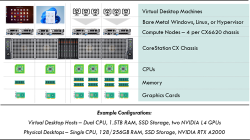Home > News & Events >

When enterprise-class servers meet the desktop
04 November 2024
Buzzwords are common in the IT world when describing technology solutions, and in this article the buzzword of the day is ‘hybrid.’ So often these hot topics are used to describe current IT trends, or the strategic direction in which a technology is headed. And hybrid most definitely falls into this category.
What do we mean when we use the word hybrid?
If we look at the dictionary definition of hybrid then it describes a blended approach to combining two different things that makes them work together as one. Think hybrid cars where a car has both internal combustion and electric motors that combine to propel the car. Or hybrid working, where an employee works both in the office and at home in order to get the job done.
If you now take hybrid and apply it as an approach to deploying IT infrastructure, then this would describe having a blended approach to on premises infrastructure, the data centre in your office, and infrastructure that is delivered and managed by a cloud service provider. From the outside, it all appears as one single set of infrastructure resources regardless of its location and who delivers it.
Adopting this approach to deploying infrastructure solutions affords you the ability to pick and choose from the best solutions that are available that deliver the best outcomes.
For example, you could have your own local on premises data centres, as well as consuming compute resource from a service provider. Whilst all working simultaneously, thismakes it a hybrid solution.
Alternatively, you could just use storage from a cloud provider and continue with on-premises infrastructure too. There are software elements too, such as software based ‘as a service’ offerings or domain and authentication services that all run from a hosted cloud platform.
Whichever resources you are consuming, one of the key reasons for adopting a hybrid approach is all about deploying the right resource, at the right time, and in the most cost-effective way as possible.
Now let’s take that hybrid approach and look at deploying desktop computing. To be clear, we’re not just talking about virtual desktop infrastructure (VDI), or Desktop-as-a-Service (DaaS), or even physical desktops. What we are talking about is that blended hybrid approach that encompasses all the above. And more importantly, how Amulet Hotkey delivers a unique solution that delivers that blended approach.
Before we dive deeper into the technology, it’s worth highlighting the reasons why this hybrid approach to delivering desktop resources delivers the best of both worlds. Amulet Hotkey’s solution, the CoreStation CX6620, is a modular and scalable server platform that supports both virtual and physical desktops all from the same chassis.
Ideal platform for delivering virtual desktops
If we look at the platform in a bit more detail, the CoreStation CX6620 is a 2U chassis that houses up to four compute nodes, or servers. Each of these servers, equivalent to just 0.5U in size, can pack in vast amounts of compute power, from dual Xeon CPUs with large capacity memory capabilities, to hosting high-end NVIDIA datacentre graphics cards.
In this guise, the CoreStation CX6620 makes the perfect hosting platform for virtual desktop infrastructure. Other platforms too, of course, but Amulet Hotkey’s solutiongoes one step further, thanks tohybridity.
Delivering physical remote desktops from the same platform
Unique to Amulet Hotkey is the ability to support desktop operating systems, such as Windows 10, Windows 11, or Linux-based environments.
Firstly, this gives you an enterprise server-class platform designed with availability and manageability features such as dual power supplies, protected storage, and above all else full remote management. A real bonus bearing in mind the infrastructure is in a datacentre somewhere remote.
And that’s not all. The remote management of desktops has always been somewhat limited, but now you have full control over the hardware. Going back to the title of this article, you can now see how enterprise-class servers meet the desktop, but what about that statement around hybridity?
Hybridity in this case refers to the fact that we can take a CoreStation CX6620 2U chassis complete with four compute nodes and have a bare metal install of Windows 11 on one node, a bare metal install of Linux on another node, and then the remaining two nodes running a hypervisor that in turn is hosting virtual desktop machines. All from that same 2U chassis. The result is a hybrid solution,blending physical and virtual in the same chassis.
A more visual representation is shown below in Figure 1:

Figure 1: CoreStation CX6620 for VDI and Physical Desktop Workloads
Furthermore, this solution can be hosted on premises if you are a corporate organisation, or delivered as a service if you are a managed or cloud service provider. And offering CoreStation-as-a-Service provides an organisation with that flexibility when delivering desktop services.
For an end user, they simply have a desktop that they can use to perform their daily tasks – whether that is physical or virtual is irrelevant to the person using it, as long as it delivers what they need.
In fact, you could even configure the solution so that for basic office tasks an end user uses a virtual desktop, and then if they need more resources, they could switch to a physical desktop.
Which leads us nicely into how to connect and consume these remote physical and virtual desktop resources.
Amulet Hotkey supports all leading desktop solutions
When it comes to the software components for delivering desktops to end users, Amulet Hotkey has a completely open and agnostic approach to what you use when it comes to brokers and display protocols.
For example, you could use Omnissa Horizon, which can broker both virtual and physical desktops, as well as allowing for direct connections without the need for a broker. The Citrix solution has a similar approach with Citrix Virtual Apps and Desktops, as do several other vendors, all of which have been certified to run on the Amulet Hotkey CoreStation platform and the Amulet Hotkey range of end point client devices.
Don’t forget the management platform
With any desktop solution, physical or virtual, a number of management functions will be needed. Whether that is basic domain and authentication services, orconnection brokers and other advanced desktop management tools. CoreStation CX6620 is a server-based solution and therefore also provides an ideal platform for delivering the management components too.
A unique hybrid solution
In summary, the Amulet Hotkey CoreStation CX6620 solution provides a unique hybrid approach to delivering both physical and virtual desktop resources using the same infrastructure. A key part of this Amulet Hotkey’s ability to fully support a desktop operating system running on a server platform.
As the experts in remote computing solutions, we have the knowledge and experience to understand your requirements and build an innovative solution not just from the server platform perspective, but as a complete solution, including the software, the implementation and the ongoing support.
Next steps
For a deeper dive into the CoreStation CX6620 solution for delivering both physical and virtual desktops, Amulet Hotkey has created a number of solution briefs detailing example hardware configurations, as well as how solutions such as Omnissa Horizon and Citrix Virtual Apps and Desktops would be deployed using the hybrid approach of delivering both physical and virtual desktops.
Get in touch to find out more.